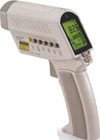

Uncovering equipment and process problems effectively with infrared thermometers.
Both preventive and predictive maintenance programmes rely on regular inspections of the critical assets that comprise a plant or facility. These inspections range from visual to non-destructive testing performed using a variety of instrumentation. While the methods vary, all inspections require plant personnel periodically to visit each of the systems, machines or equipment within the plant to anticipate the need for preventive or corrective maintenance.
Many maintenance engineers consider infrared non-contact thermometers not only indispensable for such inspections, but possibly the most important tools in their everyday work. By scanning surfaces with these temperature inspection tools users can quickly locate hot and cold spots, which could be indications of underlying problems, allowing maintenance efforts to be focused on exactly what needs repairing. Defective components are often classified according to the severity of the problem, which takes into account the absolute temperature of the component, the difference in temperature from the component to its environment, or the difference to other components in similar load situations. Handheld infrared thermometers provide a quick, safe and accurate way to collect this data. By comparing the results of inspections over time, changes in the temperature of objects can be detected and analysed to determine if failure is likely.
Most mechanical systems generate some thermal energy during normal operation and temperature monitoring can evaluate their operating condition. One of the biggest problems in mechanical systems is excessive temperature. This excessive heat can be generated by friction, lubrication degradation and coolant loss or blockage. Regular temperature monitoring of machinery components enhances the ability to predict failure and plan corrective action before a costly damage or personal injury occurs. Temperature checks should be performed regularly to locate hot spots or heat imbalances on, for example, drives and motors, bearings and transmissions, as well as hydraulic components, pumps, pulleys, and conveyors. Electrical equipment has similar demands. Bus bars with loose or oxidised joints, for example, will rapidly exhibit higher than normal temperatures due to electrical resistance.
However, simply finding the heat does not necessarily mean that a problem is present. To properly evaluate the presence of hot spots, users need to know the operating load and acceptable heat ranges for those loads as specified by the manufacturer. Even a small temperature difference of 5 to 10° can mean a major problem. Normal inspection methods alone cannot always indicate such slight temperature variations. This is where infrared inspection enters the picture – knowing the precise temperature is in some cases an absolute decision-making requirement.
With tools, such as handheld infrared thermometers, personnel can quickly and accurately measure small variations in surface temperature, taking into account all the variables of proper temperature measurement such as emissivity and reflected temperature. Infrared thermometers enable sound decision making for scheduling corrective maintenance activities and follow up repairs in the plant.
Raytek’s range of handheld infrared thermometers provides more than a temperature reading on a display. Many features are included to support maintenance inspections. These include data logging, the ability to capture and store temperature data from multiple locations along an inspection route, flexible display options such as maximum, minimum, average and differential temperature, audible alarms and Windows based software for temperature trend analysis and report preparation on a PC. For enhanced documentation, the PhotoTemp is a photographic IR thermometer with a built-in digital camera. This allows snapshots of temperature measurements, showing the measurement spot marked by a laser with temperature, time and date information. The detailed images can be easily downloaded from the unit and included in inspection reports.
| Tel: | +27 11 608 1551 |
| Email: | [email protected] |
| www: | www.randci.co.za |
| Articles: | More information and articles about R&C Instrumentation |

© Technews Publishing (Pty) Ltd | All Rights Reserved